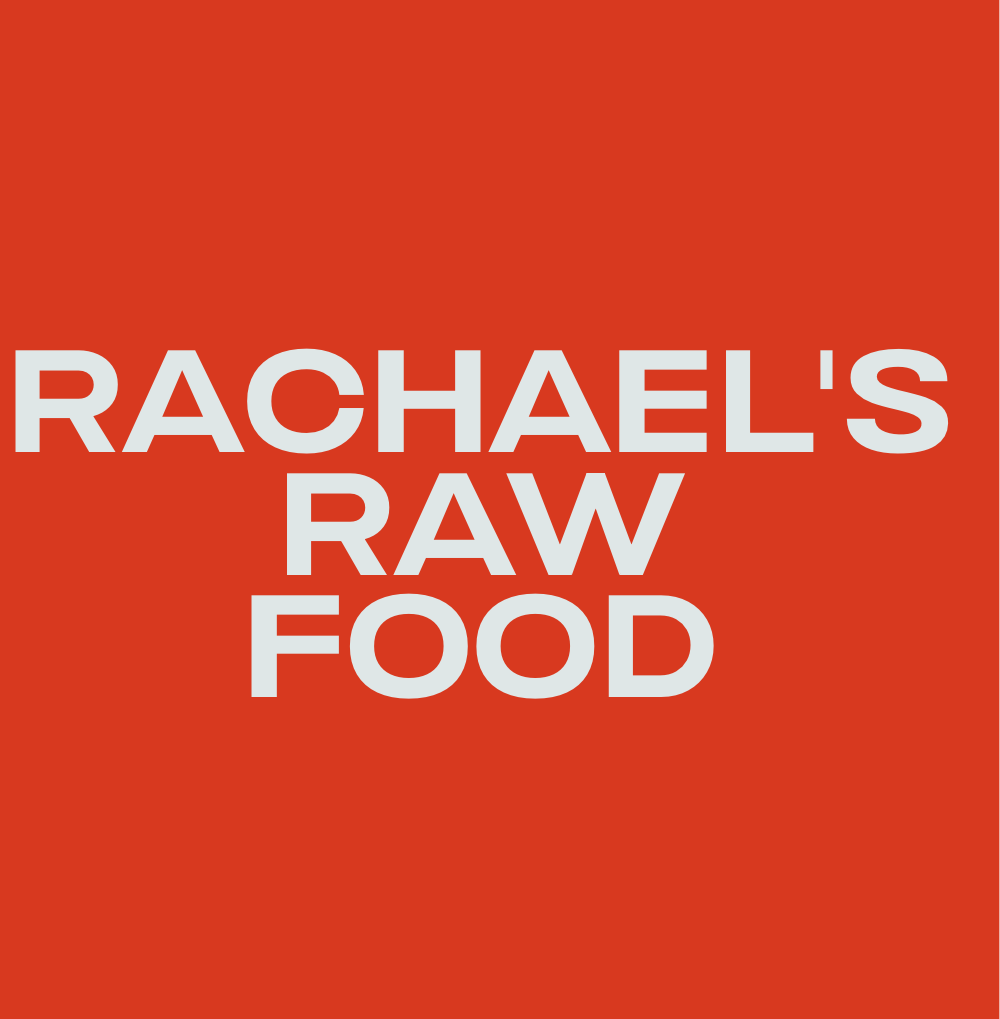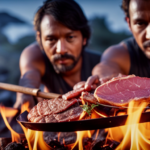Getting Started with Raw Food
Humans Didn’t Get To Where They Are By Eating Raw Food

Ever pondered how humans rose to the top of the food chain on Earth? What distinguishes us from the other creatures in the animal kingdom? The key might just be found in the act of cooking. That’s right, cooking! Humans didn’t ascend to their current position by solely consuming raw food.
Our ancestors discovered fire and harnessed its power to transform the way we eat. This seemingly mundane act of cooking had a profound impact on our evolution. In this article, we will explore the fascinating journey of how cooking shaped our species. From the nutritional benefits it provided to the evolution of our brains, cooking played a crucial role in our development.
We will also delve into how cooking brought us together as a community and became a cultural practice. Join us as we unravel the story of how cooking not only expanded our diet but also transformed agriculture and food production.
Finally, we will glimpse into the future, exploring the innovations and trends that lie ahead in the world of cooking. Get ready to discover the incredible power of cooking!
Key Takeaways
- Cooking played a crucial role in human evolution and our dominance as a species.
- The consumption of cooked food provided early humans with more energy, leading to the development of larger brains.
- Cooking enhances nutrient absorption, improves overall health and immune function.
- Cooking has shaped the development of the human brain and contributed to our cognitive abilities.
The Discovery of Fire and Its Impact on Early Humans
The discovery of fire was a game-changer for early humans, igniting a flame of progress that forever transformed our existence. Early humans quickly realized the benefits of cooking food and relied on it for survival. Cooking food made it easier to digest and increased its nutritional value. This allowed early humans to access a wider range of nutrients and energy, leading to improved health and brain development.
The cultural significance of fire and cooking in early human societies can’t be overstated. Fire provided warmth, protection, and light, allowing early humans to extend their activities into the night. It also became a central gathering place, fostering social interaction and the sharing of knowledge. The ability to cook food together created a sense of community and cooperation, reinforcing social bonds among early human groups.
Furthermore, cooking food had a profound impact on our evolution. The consumption of cooked food provided early humans with more energy, allowing them to develop larger brains. This increase in brain size and capacity played a crucial role in our cognitive development and ability to adapt to changing environments.
The discovery of fire and the subsequent reliance on cooked food revolutionized early human societies. Fire not only provided practical benefits but also had a significant cultural and evolutionary impact. It paved the way for the progress and advancements that have shaped the course of human history.
The Nutritional Benefits of Cooking
Start experiencing the nutritional benefits of cooking by incorporating it into your diet. Cooking has played a significant role in the evolution of humans and has provided numerous health benefits. Here are four reasons why cooking your food can be beneficial for your overall well-being:
-
Enhanced Nutrient Absorption: Cooking breaks down the cell walls of plants and animals, making it easier for your body to absorb essential nutrients like vitamins and minerals. This can contribute to better overall health and improved immune function.
-
Increased Antioxidant Availability: Cooking certain foods can increase the availability of antioxidants, which help protect your body against harmful free radicals. For example, cooking tomatoes increases the bioavailability of lycopene, a powerful antioxidant that may reduce the risk of certain diseases.
-
Improved Digestibility: Cooking can make certain foods easier to digest by breaking down complex carbohydrates and proteins. This can alleviate digestive issues and enhance nutrient absorption.
-
Culinary Creativity: Cooking allows you to experiment with different flavors, textures, and cooking methods. By exploring new recipes and techniques, you can broaden your culinary horizons and create delicious, nutritious meals that satisfy both your taste buds and your nutritional needs.
Incorporating cooking into your routine can provide you with a multitude of health benefits and allow you to unleash your culinary creativity. So, start exploring the world of cooking and enjoy the nutritious rewards it brings.
Cooking and the Evolution of the Human Brain
Cooking has played a pivotal role in the development of the human brain, shaping our cognitive abilities and contributing to our evolutionary success. The act of cooking our food has allowed us to access a greater variety of nutrients and energy sources, leading to the growth and development of our brain.
Cooking breaks down complex molecules, making them easier to digest and absorb. This process not only increases the efficiency of nutrient absorption but also allows for the release of more energy-rich compounds, fueling the growth and functioning of our brain.
Furthermore, cooking has had a profound impact on the development of language in humans. The ability to cook and share meals has fostered social interactions and cooperation among early human communities. This increased socialization provided an environment for the development and refinement of language, allowing for the exchange of information, ideas, and cultural practices.
Cooking brought people together, creating opportunities for communication and the transmission of knowledge from one generation to the next.
Cooking has been a key factor in the development of the human brain and the evolution of our species. Through cooking, we have gained access to a wider range of nutrients, fueling the growth and functioning of our cognitive abilities. Additionally, cooking has facilitated social interactions and the development of language, shaping our cultural and intellectual advancements.
The act of cooking has been instrumental in our journey as a species, contributing to our evolutionary success.
The Role of Cooking in Socialization and Community Building
Imagine a world where people gathered around a fire, sharing deliciously cooked meals, and forming tight-knit communities that thrived on social interaction and cooperation. Cooking plays a crucial role in building relationships and fostering socialization within communities. It serves as a form of expression, allowing individuals to showcase their creativity and cultural heritage through the preparation and presentation of food.
Cooking brings people together in various ways. First, it creates a sense of belonging and unity. When individuals gather to cook and share meals, they engage in a collaborative activity that fosters a sense of community and togetherness. It provides an opportunity for individuals to connect, bond, and strengthen existing relationships.
Furthermore, cooking facilitates communication and interaction among community members. As people prepare meals together, they engage in conversations, exchange stories, and share experiences. This not only strengthens social ties but also promotes understanding, empathy, and cultural exchange.
Cooking allows individuals to express their creativity and identity. Through food, people can showcase their unique cultural practices, traditions, and personal tastes. This promotes diversity and appreciation for different cultures within a community.
In conclusion, cooking is more than just a means to nourish our bodies. It serves as a powerful tool for building relationships, fostering socialization, and expressing one’s identity. By sharing delicious meals around a fire, communities can come together, form tight-knit bonds, and thrive on social interaction and cooperation.
Cooking as a Cultural Practice
As you gather around the fire, the tantalizing aromas wafting through the air, you immerse yourself in the rich tapestry of cultural practices that cooking brings to life. Cooking has played a significant role in shaping human culture and has been a vital part of our historical evolution.
The cultural significance of cooking goes beyond mere sustenance; it’s a way for communities to come together, share stories, and pass down traditions from generation to generation.
Throughout history, cooking has been a means of survival and has allowed humans to thrive in various environments. The ability to cook food has given us an evolutionary advantage by making it easier to digest and extract nutrients from a wider range of ingredients. This innovation allowed for the diversification of our diets and the exploration of new culinary possibilities.
Cooking also acts as a powerful cultural marker, defining the identity of different communities. Each culture has its unique cooking practices, ingredients, and flavors. Traditional recipes and cooking techniques are passed down through generations, preserving cultural heritage and fostering a sense of belonging.
Furthermore, cooking has been a catalyst for socialization and community building. The act of preparing and sharing meals brings people together, promoting communication, bonding, and a sense of unity. From ancient civilizations gathering around communal fires to modern-day family dinners, cooking has always been a way for humans to connect and strengthen social ties.
Cooking as a cultural practice has played a crucial role in shaping human history and society. Its cultural significance and historical evolution have allowed for the development of diverse culinary traditions and have fostered a sense of community and belonging. So, as you savor the delicious flavors of a home-cooked meal, remember that you’re participating in a practice that has shaped human culture for millennia.
The Development of Culinary Techniques and Recipes
When you delve into the history of culinary techniques and recipes, do you ever wonder how ancient civilizations discovered the perfect combination of ingredients and cooking methods to create delicious meals? The development of culinary techniques and recipes can be seen as a series of culinary inventions throughout history.
As humans began to explore different methods of cooking, they discovered new ways to enhance the flavors and textures of their food. One of the earliest historical cooking techniques was the use of fire. The ability to control and manipulate fire allowed early humans to cook their food, making it more digestible and safer to eat. This discovery not only provided a source of heat for cooking but also opened up a whole new world of culinary possibilities.
Over time, humans began to experiment with different cooking techniques, such as boiling, roasting, and baking. These techniques allowed for the development of a wide variety of dishes and flavors. Additionally, the invention of tools, such as pots and ovens, further expanded the range of culinary possibilities.
As civilizations developed and interacted with each other, culinary techniques and recipes were shared and adapted. The exchange of ingredients and cooking methods led to the creation of new and unique dishes. The development of trade routes and the exploration of new lands also played a significant role in the evolution of culinary techniques and recipes.
The development of culinary techniques and recipes is a result of human curiosity and experimentation. Through the ages, humans have continuously discovered and refined new methods of cooking, leading to the creation of diverse and delicious meals. The historical cooking techniques and culinary inventions have shaped the way we eat and enjoy food today.
Cooking and the Expansion of Human Diet
Get ready to explore a world of culinary adventure as you discover how cooking revolutionized human diets and opened up a whole new realm of delicious possibilities. The evolution of cooking techniques played a crucial role in the expansion of human diet.
Early humans discovered that by using heat, they could transform raw ingredients into more palatable and digestible forms. This allowed them to consume a wider variety of foods, including tough meats and fibrous vegetables that would have been otherwise difficult to chew and digest.
But cooking did more than just make food easier to eat. It also had a profound impact on human health. Through the cooking process, harmful bacteria and parasites were eliminated, reducing the risk of foodborne illnesses. Additionally, cooking helped to break down certain compounds in food, making essential nutrients more accessible to our bodies. For example, cooking breaks down the cell walls of plants, releasing valuable nutrients such as vitamins and minerals.
The introduction of cooking techniques not only expanded our dietary options but also contributed to the development of our species. By consuming a wider range of foods, early humans were able to obtain the necessary nutrients for brain growth and development. This, in turn, played a crucial role in the evolution of our cognitive abilities.
The evolution of cooking techniques had a transformative effect on human diets and health. By making food more digestible and eliminating harmful pathogens, cooking opened up a world of culinary possibilities and contributed to the development of our species.
So, next time you enjoy a delicious cooked meal, remember to thank the ancient innovators who paved the way for our culinary adventures.
How Cooking Transformed Agriculture and Food Production
Prepare to be amazed as you journey through the transformative power of cooking, which turned the soil of agriculture and food production into a fertile garden of possibilities. Cooking not only expanded the human diet, but it also had a profound impact on food preservation.
Through the application of heat, cooking effectively kills harmful bacteria and parasites, making food safer to consume and extending its shelf life.
The evolution of cooking utensils played a crucial role in this transformation. From the invention of simple tools like sharpened sticks and rocks to the development of more sophisticated cooking vessels like clay pots and metal pans, each innovation allowed humans to explore new cooking techniques and create a wider range of delicious and nutritious meals. These utensils also helped to control the temperature and distribute heat more evenly, leading to improved cooking efficiency and better food quality.
In addition to its impact on food preservation and the evolution of cooking utensils, cooking has also influenced the way we cultivate and produce food. The introduction of fire allowed early humans to clear land for agriculture, making it easier to grow crops and rear livestock. Cooking also made it possible to process and store large quantities of food, enabling communities to thrive and civilizations to flourish.
The transformative power of cooking cannot be overstated. It not only expanded our diet and improved food preservation but also revolutionized agriculture and food production. Through the evolution of cooking utensils and the application of heat, cooking has forever changed the way we eat and live.
The Industrial Revolution and the Modernization of Cooking
Now that we’ve explored how cooking transformed agriculture and food production, let’s delve into the impact of the Industrial Revolution and the modernization of cooking.
During the Industrial Revolution, the world experienced a significant shift in manufacturing and production processes. This period marked a turning point in the way people cooked and prepared their food. Industrialization brought about technological advancements that revolutionized the cooking industry.
With the introduction of new machinery, such as stoves, ovens, and refrigerators, cooking became more efficient and convenient. These technological advancements enabled people to cook larger quantities of food in a shorter amount of time. Additionally, the development of canning and preserving techniques allowed for longer shelf lives of food, reducing the need for immediate consumption.
The industrialization of cooking also had a profound impact on the availability and variety of ingredients. Improved transportation systems and refrigeration methods made it possible to import and store food from distant regions. This led to the globalization of cuisine and a wider range of flavors and ingredients in people’s diets.
The Industrial Revolution and the modernization of cooking brought about significant changes in how we prepare and consume food. Technological advancements played a crucial role in making cooking more efficient, convenient, and diverse.
The Future of Cooking: Innovations and Trends
Imagine a future where you effortlessly cook gourmet meals with the help of cutting-edge technology and mouthwatering flavors that transport you to culinary heaven. Thanks to innovative cooking appliances and the rise of molecular gastronomy, this future is becoming a reality.
In this future, you’ll have access to a wide range of innovative cooking appliances that make cooking a breeze. From smart ovens that can be controlled remotely to precision cookers that ensure your food’s cooked to perfection every time, these appliances will revolutionize the way you cook. With just a few taps on your smartphone or voice commands to your virtual assistant, you can create delicious meals without breaking a sweat.
Molecular gastronomy, a scientific approach to cooking, will also play a significant role in the future of cooking. This culinary movement explores the chemical and physical transformations that occur during the cooking process, resulting in unique and exciting dishes. By understanding the science behind cooking, chefs can experiment with new flavors and textures, pushing the boundaries of traditional cuisine.
To fully enjoy these advancements, here are two sub-lists to guide you:
-
Innovative cooking appliances:
- Smart ovens with remote control capabilities
- Precision cookers for perfectly cooked food
-
Molecular gastronomy:
- Exploring the chemical and physical transformations in cooking
- Experimenting with new flavors and textures
With these advancements, cooking in the future will be a delightful experience, allowing you to create restaurant-quality meals in the comfort of your own home. So, get ready to embark on a culinary journey like no other.
Frequently Asked Questions
How did early humans discover fire and its potential for cooking?
Early humans discovered fire and its potential for cooking through a process of trial and error. They originated this discovery by experimenting with various methods of creating and controlling fire.
One interesting statistic is that evidence suggests early humans began using fire for cooking as early as 1.9 million years ago. This discovery had a significant impact on human evolution, as cooking allowed for the consumption of a wider range of foods and provided more efficient nutrient absorption.
What are the specific nutritional benefits of cooking food?
Cooking food provides specific nutritional benefits, and the heat involved plays a crucial role. Heat helps break down the complex carbohydrates, proteins, and fats present in food, making them easier to digest and absorb. It also destroys harmful bacteria and parasites, reducing the risk of foodborne illnesses.
Cooking can increase the bioavailability of certain nutrients, like lycopene in tomatoes. Additionally, heat can enhance the flavors and aromas of food, making it more enjoyable and palatable.
How did cooking contribute to the evolution and development of the human brain?
Cooking played a crucial role in the evolutionary advantages and cognitive development of the human brain. By cooking food, early humans gained access to a wider range of nutrients, which supported brain growth and development.
The increased energy obtained from cooked food allowed for the expansion of the brain, leading to improved cognitive abilities. Furthermore, cooking made food easier to digest, saving energy that could be allocated towards brain functioning and other activities.
In what ways did cooking play a role in the socialization and community building of early humans?
Cooking played a vital role in the socialization and community building of early humans. Social rituals and culinary traditions were developed around the fire, creating a sense of togetherness and belonging. Sharing a meal became a way to strengthen bonds and foster cooperation. Through cooking, early humans could exchange knowledge, stories, and experiences, creating a foundation for the development of complex societies.
These communal gatherings around the fire laid the groundwork for human socialization as we know it today.
How did cooking practices vary across different cultures and societies throughout history?
Culinary techniques in ancient civilizations varied widely, reflecting the diverse cultures and societies of the time. For example, the ancient Egyptians developed advanced baking methods, while the Greeks and Romans focused on roasting and boiling. These cooking practices were not just about nourishment, but they also held great cultural significance.
Food preparation methods were often intertwined with religious rituals and social customs, fostering a sense of community and reinforcing social hierarchies. These practices played a crucial role in shaping the social fabric of early civilizations.
How Does Cooking Food Contribute to Human Evolution and Development?
Cooking food has been a crucial factor in human evolution and development. It is believed to have started around 2 million years ago, enabling our ancestors to consume more nutrients and spend less time chewing. The “hells kitchen raw food rumor” has been debunked by scientists, highlighting the importance of cooking in our history.
Conclusion
In conclusion, you’ve now discovered the profound impact that cooking has had on the development of humanity. From the discovery of fire to the evolution of our brains, cooking has played a crucial role in our progress.
It hasn’t only provided us with nutritional benefits and expanded our diet, but it’s also fostered socialization and community building.
As we continue to innovate and explore new culinary frontiers, cooking will undoubtedly shape the future of food and our relationship with it.
The journey of cooking isn’t over, and the possibilities are endless.
With her ability to convey complex concepts in a clear and accessible manner, Belinda ensures that readers of all backgrounds can grasp the benefits and techniques of raw food. She excels at breaking down scientific information into digestible pieces, allowing readers to understand the impact of raw food on their bodies and encouraging them to make informed choices about their diet.
One of Belinda’s notable contributions to rachaelsrawfood.com is her collection of mouthwatering recipes. She delights in experimenting with various combinations of raw ingredients, exploring innovative ways to create delicious and nutritious meals. Belinda’s recipes showcase the incredible flavors and textures of raw food and emphasize its versatility, dispelling any misconception that a raw food diet is limited or monotonous.
In addition to her writing responsibilities, Belinda actively engages with the raw food community, attending workshops, seminars, and conferences to expand her knowledge and network. She enjoys connecting with like-minded individuals, exchanging ideas, and staying up to date with the latest trends and advancements in the field of raw food nutrition.
Getting Started with Raw Food
Does Raw Food Make Dogs Constipated? Find Out Here
Observe the signs of constipation in dogs on a raw food diet; discover how to ensure their digestive health. What solutions exist?

Feeding your dog a raw food diet can indeed cause constipation if it isn't balanced right. Excessive bone content might lead to hard stools, while not including enough fiber from fruits and vegetables can worsen the issue. Dehydration is also common with raw diets, contributing to stool hardness. If you notice signs like straining to defecate or rock-hard stools, it's important to adjust the diet. Adding fiber-rich foods like pumpkin and keeping your dog hydrated are key. There's more you can do to guarantee a healthy digestion for your dog, so keep exploring options for their diet.
Key Takeaways
- Raw diets can lead to constipation due to excessive bone content resulting in hard stools.
- Insufficient fiber from a lack of fruits and vegetables can exacerbate digestive issues.
- Dehydration is common in raw diets, which contributes to stool hardness.
- Rapid transitions to a raw diet without gradual adjustments may disrupt a dog's digestion.
- Regular monitoring of stool consistency and dietary balance is essential for preventing constipation.
Understanding Dog Constipation
Constipation in dogs can be a concerning issue for pet owners, and it's important to recognize the signs early. You might notice that your dog hasn't had a bowel movement for over 24 hours, is straining while trying to defecate, or producing rock-hard stools. These symptoms indicate that your dog's digestive tract needs attention.
Diet plays an essential role in your dog's bowel health, and understanding proper hamster care can help you appreciate the importance of nutrition in pet health. If your dog is on a raw diet, insufficient fiber and excessive bone content can contribute to constipation. It's crucial to provide enough fiber to help your dog maintain regular bowel movements. Foods like pumpkin and leafy greens can be excellent additions to their diet.
Additionally, keep an eye on your dog's hydration and make sure they get plenty of exercise. Both of these factors are significant for promoting healthy digestion and preventing constipation.
If you're concerned about your dog's condition, consider adjusting their diet by reducing bone content and incorporating fiber-rich foods. By taking these steps, you can help your dog overcome constipation and support their overall health.
Causes of Constipation in Raw Diets
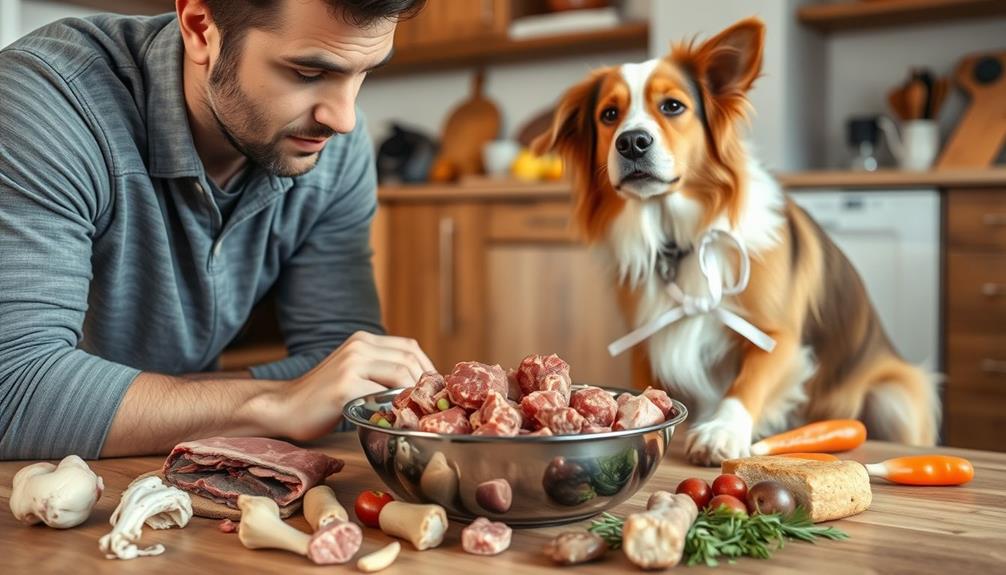
A raw diet can sometimes lead to constipation in dogs, primarily due to excessive bone content. When the diet consists of too many bones, it can result in hard stools that hinder regular bowel movements.
Additionally, insufficient fiber intake from a lack of fruits and vegetables can exacerbate the problem. It's essential to incorporate fiber-rich foods like pumpkin and leafy greens to support healthy digestion, as recommended in gout nutrition guidelines.
Dehydration also plays a significant role in constipation. Since raw diets often contain less moisture than processed foods, your dog may not be drinking enough water, further contributing to hard stools.
Stress, changes in routine, or dietary imbalances can influence gut motility, leading to irregular bowel movements as well.
Moreover, if you shift your pet to a raw diet too quickly without a gradual introduction of new foods, it can disrupt their digestive system. This sudden change may result in constipation or other gastrointestinal issues.
To prevent these causes of constipation, verify that your dog's raw diet is balanced and includes sufficient fiber and hydration. This way, you can help maintain your dog's digestive health.
Signs and Symptoms to Observe

Recognizing the signs and symptoms of constipation in your dog is essential for timely intervention. Pay close attention to any lack of stool for over 24 hours, as this can be a clear indication that your dog is experiencing constipation.
If you notice your dog is straining during defecation, it's vital to take action. Straining often accompanies hard stools that resemble pebbles, signaling that your dog may be in discomfort. Additionally, providing your dog with healthy snacks can promote better digestion and overall health, potentially mitigating constipation issues.
Behavioral changes can also be significant. If your dog seems reluctant to move, avoids activities they usually enjoy, or shows signs of discomfort while attempting to relieve themselves, these may be warning signs of constipation.
It's important to monitor stool consistency regularly. Hard stools can lead to further complications, so keeping an eye on your dog's bathroom habits is key.
Dietary Adjustments for Relief
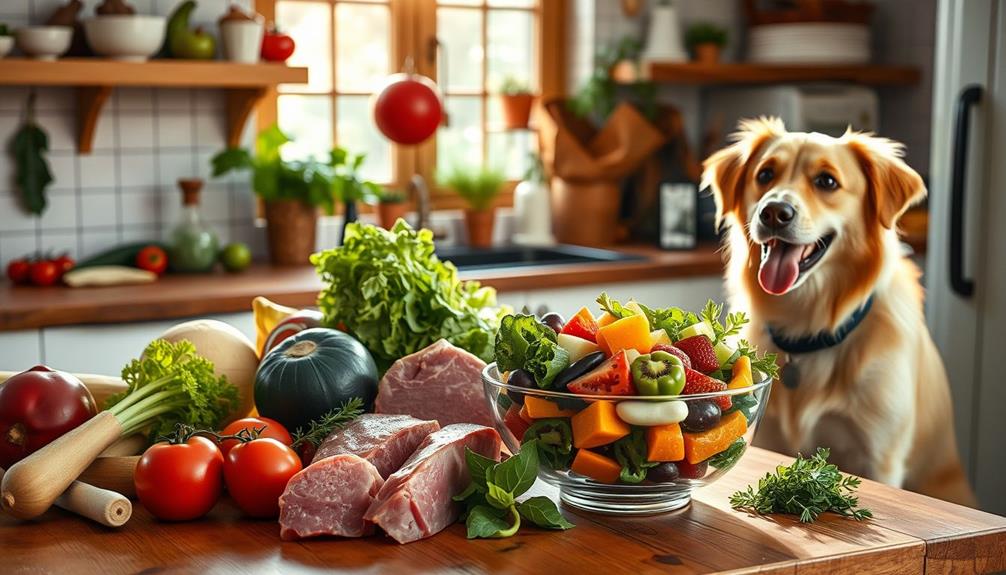
Making dietary adjustments can greatly help alleviate your dog's constipation. Start by reducing the frequency of raw meaty bones in their diet, as these can lead to drier, harder stools.
Instead, focus on incorporating extra fruits and vegetables, like pumpkin or leafy greens, which provide essential fiber that aids in regulating bowel movements. Additionally, guaranteeing proper hydration is vital; consider how air quality considerations can parallel maintaining your dog's overall health, including digestive wellness.
Feeding a balanced raw diet consisting of 80% muscle meat, 10% bone, and 10% offal guarantees your dog gets adequate moisture and nutrients, promoting healthy digestion.
Pureed pumpkin or canned unsweetened pumpkin can be particularly effective, thanks to its high fiber content, making it easier for your dog to defecate without straining.
Don't forget about hydration! Make sure your dog has access to fresh water or bone broth, as regular hydration is essential for maintaining stool consistency and preventing constipation.
By making these dietary adjustments, you'll create a more balanced raw food experience that supports your dog's digestive health and helps alleviate constipation.
Supplement Options for Digestive Health
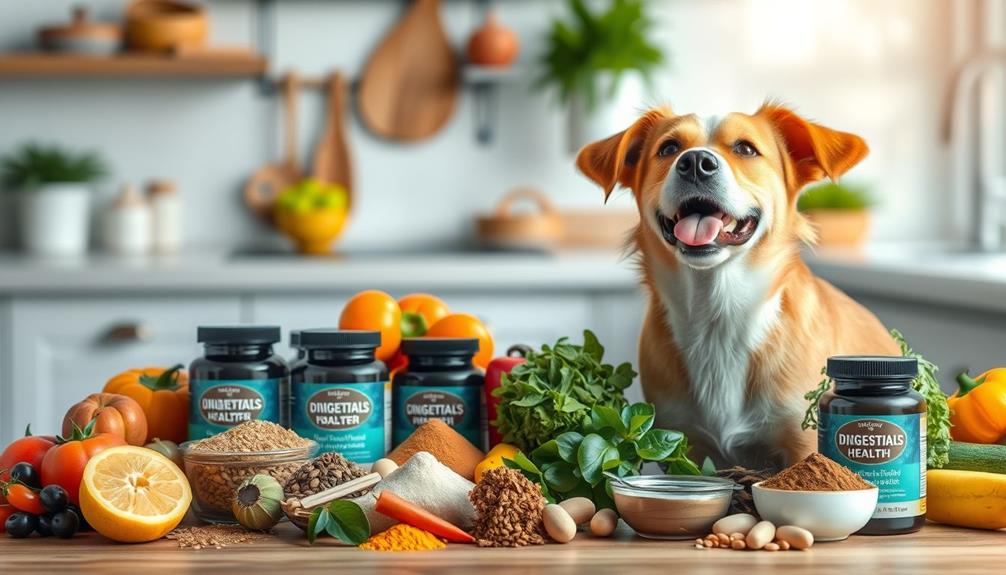
How can you enhance your dog's digestive health while minimizing constipation? Exploring effective supplement options can make a significant difference. Here are some to evaluate:
- Probiotics: These promote a diverse gut microbiome, which is essential for good digestion and can help mitigate issues such as gastrointestinal issues.
- Digestive enzymes: They help break down raw proteins and fats, improving nutrient absorption.
- Slippery elm: This natural remedy soothes the gastrointestinal tract and creates a protective mucous lining. A dosage of ¼ teaspoon per 10 lbs of body weight is recommended.
- Leafy greens: Incorporating fiber-rich foods like kale or spinach can regulate bowel movements, alleviating constipation.
- Omega-3 oil: Regular supplementation with this healthy oil supports overall digestive health and improves stool consistency.
When to Consult a Veterinarian
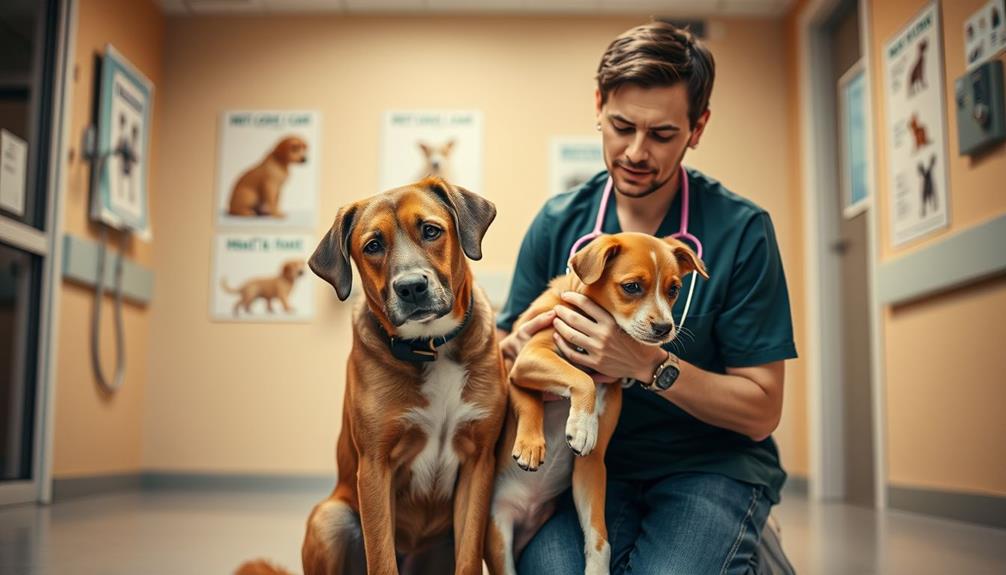
If your dog hasn't had a bowel movement in over 24 hours, it's time to consult a veterinarian.
It's important to keep an eye on your dog's overall behavior and health, as changes can indicate underlying issues that may require immediate attention.
Look out for persistent straining, discomfort, or any behavioral changes that indicate pain.
Addressing these signs early can help prevent more serious health issues down the line.
Additionally, emotional and psychological support available for families can be beneficial during such stressful times.
Persistent Lack of Stool
When your dog goes more than 24 hours without a stool, it's time to consult a veterinarian to rule out any serious health issues. A persistent lack of stool can indicate underlying problems that need addressing.
Here are some signs to watch for:
- Decreased energy levels or reluctance to move
- Hard, rock-like stools that signal constipation
- Straining to defecate with little or no output
- Signs of pain during attempts to relieve themselves
- Changes in appetite or behavior, indicating discomfort
If your dog's raw food diet lacks fiber, it could cause constipation, leading to infrequent dogs' bowel movements. Adding vegetables such as spinach, carrots, and sweet potatoes to their diet can help increase the fiber content and improve their digestion. It is important to consult with a veterinarian before switching to raw dog food, as they can provide guidance on the best diet for your dog’s specific needs. In some cases, adding a fiber supplement may also be necessary to ensure your dog’s digestive health.
Creating a personal budget for your pet's dietary needs can guarantee they receive the right nutrients. Loose stools can also disrupt gut health, making it essential to maintain a balanced diet.
If you notice any of these symptoms, don't hesitate to seek veterinary advice. Early intervention is key to identifying and treating the root cause of your dog's persistent lack of stool.
Delaying could complicate the situation, so it's best to act promptly. Remember, your dog's well-being depends on your vigilance in recognizing these signs!
Straining and Discomfort Signs
Straining to defecate can be a clear sign that your dog is experiencing constipation, and it's important to recognize this symptom early.Breast cancer symptoms in dogs can sometimes mimic signs of discomfort, so it's vital to differentiate between the two. If you notice your dog straining excessively or having difficulty passing stool, it's necessary to consult a veterinarian, especially if this persists. Signs of discomfort, like whining or trembling while attempting to defecate, should prompt an immediate visit to the vet.
A lack of bowel movements for more than 24 hours is a significant indicator of constipation and requires professional evaluation to rule out any underlying issues. Additionally, if your dog produces rock-hard stool consistently, this often signifies constipation, and you should seek veterinary advice.
Keep an eye on any changes in your dog's behavior; decreased activity levels or reluctance to move may also signal discomfort related to being constipated.
Addressing these signs of discomfort promptly can help prevent more serious health problems down the line. Remember, when in doubt about your dog's bowel habits or overall well-being, don't hesitate to reach out for a veterinary consultation. Your dog's health and comfort should always come first.
Behavioral Changes and Pain
Recognizing behavioral changes in your dog can provide important clues about their health, especially regarding constipation.
Similar to individuals with BPD dynamics in relationships, dogs may exhibit changes in behavior when experiencing discomfort or pain. If your dog exhibits any of the following signs, it's time to reflect on a vet consultation:
- Reluctance to move or play
- Straining and difficulty when trying to defecate
- Whining or trembling during attempts to have a bowel movement
- Rock-hard stools that are difficult to pass
- An absence of bowel movements for more than 24 hours
These signs of pain and discomfort can indicate that your dog needs immediate attention.
Straining to defecate is a clear indicator of constipation, and if your pet struggles for over a day, it may suggest a more serious underlying issue. Obvious signs of distress during defecation, such as whining, should never be ignored.
If you notice any of these behavioral changes, don't hesitate to consult your vet.
Early intervention can prevent complications and guarantee your dog's digestive health is maintained.
Frequently Asked Questions
Is It Normal for Dogs to Poop Less on a Raw Diet?
It's normal for dogs to poop less on a raw diet. You'll notice smaller, firmer stools due to higher digestibility. Just keep an eye out for any signs of constipation or distress in your dog.
How Do You Soften a Dog's Poop on a Raw Diet?
Did you know that 60% of dog owners notice firmer stools on a raw diet? To soften your dog's poop, balance their meals, add fiber, guarantee hydration, and encourage daily exercise for ideal digestive health.
What Foods Cause Dogs to Be Constipated?
Certain foods can cause constipation in dogs. High bone content, low-fiber diets, dry kibble, excessive lean meats, and non-digestible items like toys can all contribute to hard stools. Guarantee a balanced diet to prevent this.
How Long Does It Take for a Dog to Digest Raw Food and Poop?
It usually takes your dog 12 to 24 hours to digest raw food, depending on their age and size. You might notice smaller, less frequent stools due to improved nutrient absorption from the diet.
Conclusion
To sum up, while a raw food diet can be beneficial for many dogs, it can also lead to constipation if not balanced properly. Keep an eye on your pup's signs and symptoms, and make dietary adjustments as needed. If the issue persists, don't hesitate to consult your veterinarian, who can help you navigate this digestive maze. Remember, with the right approach, you can keep your dog's tummy happier than a kid in a candy store!
With her ability to convey complex concepts in a clear and accessible manner, Belinda ensures that readers of all backgrounds can grasp the benefits and techniques of raw food. She excels at breaking down scientific information into digestible pieces, allowing readers to understand the impact of raw food on their bodies and encouraging them to make informed choices about their diet.
One of Belinda’s notable contributions to rachaelsrawfood.com is her collection of mouthwatering recipes. She delights in experimenting with various combinations of raw ingredients, exploring innovative ways to create delicious and nutritious meals. Belinda’s recipes showcase the incredible flavors and textures of raw food and emphasize its versatility, dispelling any misconception that a raw food diet is limited or monotonous.
In addition to her writing responsibilities, Belinda actively engages with the raw food community, attending workshops, seminars, and conferences to expand her knowledge and network. She enjoys connecting with like-minded individuals, exchanging ideas, and staying up to date with the latest trends and advancements in the field of raw food nutrition.
Getting Started with Raw Food
Why Is Raw Food Bad for Cats? Essential Information
Overlooking the dangers of raw food diets for cats can lead to serious health risks; discover what you need to know for your feline’s safety.
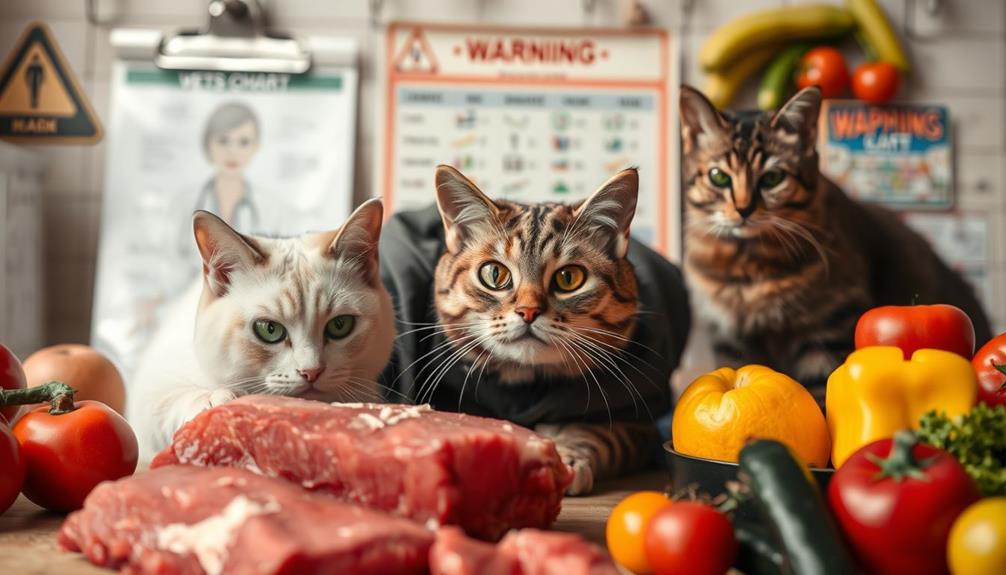
Feeding your cat a raw food diet can be risky due to harmful bacteria like Salmonella and E. coli, which can cause severe gastrointestinal issues such as vomiting and diarrhea. About 25% of raw pet food samples have tested positive for these pathogens. Additionally, raw diets often lack essential nutrients like taurine, which can lead to serious health problems over time. Contamination during preparation increases health risks not just for your cat but for humans as well. Safety practices are vital if you decide to go this route, but there are safer, balanced alternatives that might better meet your cat's needs.
Key Takeaways
- Raw food diets can expose cats to harmful pathogens like Salmonella and E. coli, posing health risks to both pets and humans.
- Nutritional deficiencies are common in raw diets, lacking essential nutrients necessary for a cat's overall health and development.
- Improper preparation and handling of raw food increase the risk of contamination, leading to severe gastrointestinal issues in cats.
- Cats can be asymptomatic carriers of pathogens, increasing the risk of transmitting infections to humans through raw food.
- High-quality commercial cat foods offer balanced nutrition and are safer alternatives, minimizing health risks associated with raw diets.
Health Risks of Raw Food
When considering a raw food diet for your cat, it's vital to understand the health risks involved. Raw food diets can carry significant contamination risks with harmful pathogens such as Salmonella and E. coli. Studies indicate that nearly 25% of raw pet food samples test positive for these bacteria. The CDC estimates that there are about 1.2 million annual cases of foodborne salmonellosis in the U.S., and your cat could act as an asymptomatic carrier, increasing the risk of human exposure.
Additionally, just as in financial planning for elderly care, understanding the long-term impact of dietary choices is important for maintaining overall health and well-being.
Moreover, Listeria monocytogenes, another pathogen found in raw diets, poses serious dangers, especially for vulnerable populations like pregnant women and newborns. Cats fed raw diets may experience gastrointestinal issues such as vomiting and diarrhea, which can lead to severe health consequences for both them and their human caregivers.
Veterinary organizations like the CDC and AVMA strongly advise against raw diets due to these health risks. They emphasize the importance of safe handling practices to minimize contamination, but even with precautions, the dangers of raw pet food remain significant.
Ultimately, you must weigh these risks carefully when considering your cat's diet.
Nutritional Concerns
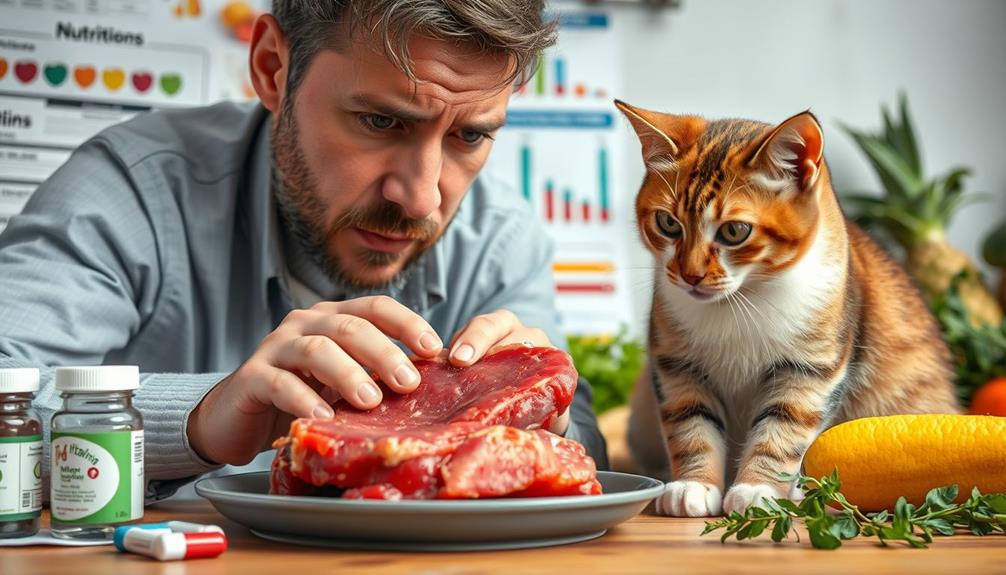
Cats thrive on balanced nutrition, but raw food diets often fall short in providing essential nutrients. Many raw food diets lack essential components like taurine, vitamins A, D, and E, which are critical for your cat's health. Without these essential nutrients, your feline friend could face serious nutritional deficiencies that lead to health issues over time.
Furthermore, it's important to understand the implications of dietary choices on overall health and wellness, as proper budgeting for pet care guarantees your cat receives the best nutrition possible.
Homemade raw diets frequently miss the mark on meeting complete and balanced nutritional requirements. This oversight can result in calcium imbalances, affecting bone health and overall development, particularly in growing cats. In adult cats, these imbalances can also lead to significant health concerns.
Additionally, without veterinary guidance, feeding your cat a raw food diet can be risky. Only a small percentage of analyzed homemade raw diets have been found to be complete and balanced. The potential for harmful bacteria in raw diets can further complicate nutritional adequacy, as it may contribute to nutrient loss.
To guarantee your cat receives the balanced diet they need, consult with a veterinarian before making any changes to their diet, especially if you're considering raw food options.
Pathogen Contamination
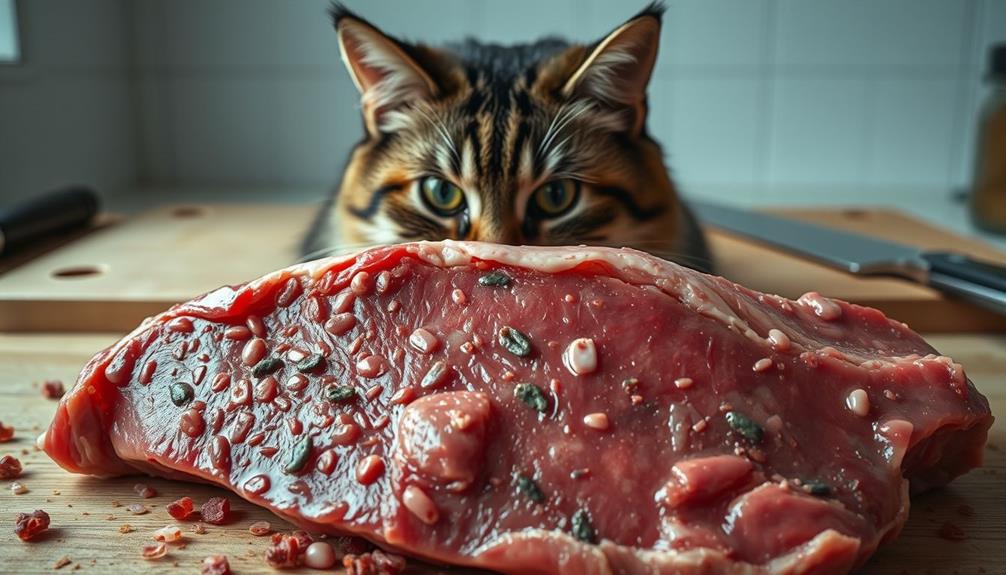
Feeding your cat a raw food diet can open the door to serious health risks, particularly due to pathogen contamination. Studies show that nearly 25% of raw cat food samples are contaminated with harmful bacteria, including Salmonella and Listeria.
These pathogens can pose significant risks not only to your cat but also to your household. Pets with emotional dysregulation, such as those with BPD dynamics in relationships, may also exhibit increased anxiety, making them more vulnerable to health issues.
Salmonella, for instance, causes around 1.2 million human infections each year, with cats often acting as asymptomatic carriers, increasing the chance of transmission to humans.
Listeria monocytogenes, another common threat in raw diets, leads to severe foodborne illnesses, contributing to approximately 1,600 cases and 260 deaths annually in the US. The risks escalate, especially in households with young children or immunocompromised individuals, as they're more vulnerable to these pathogens.
Improper preparation and handling raw food can exacerbate the risks of contamination, making it critical to understand the serious implications of a raw diet.
While your cat may enjoy the taste, the potential health hazards from contaminated raw cat food can lead to dire consequences for both your pet and your family.
Safe Handling Practices
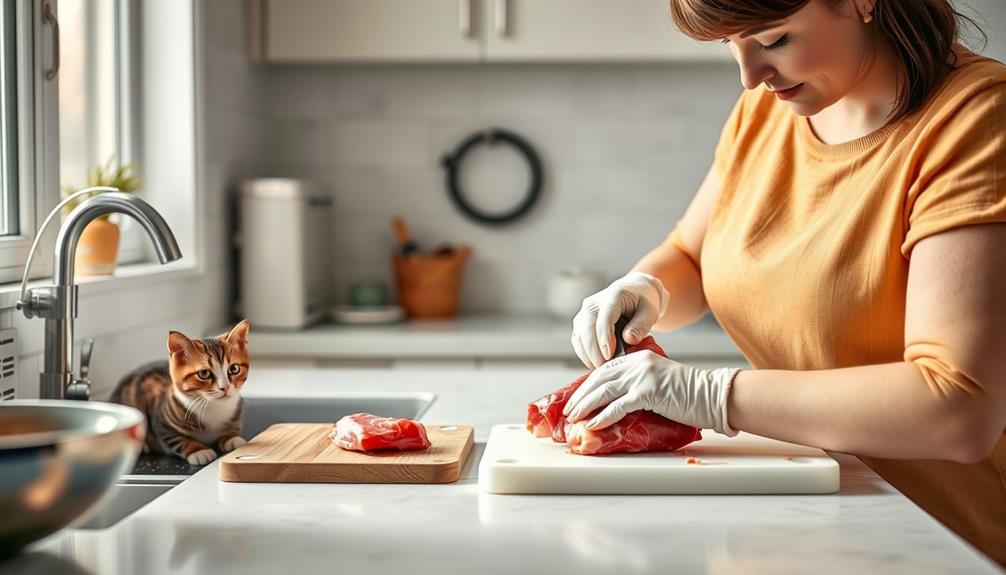
Practicing safe handling techniques is vital to minimize the risks associated with feeding your cat a raw food diet. As a pet parent, you need to be vigilant about harmful bacteria like Salmonella and Listeria that can thrive in raw cat food.
Regularly monitoring your cat's health for any signs of illness can also be beneficial, as certain dietary choices may impact their well-being, including ultimate hamster care. Always wash your hands thoroughly with soap and water after handling any raw food. This simple step helps prevent the spread of these pathogens.
To guarantee a safe environment, clean and disinfect all surfaces, utensils, and feeding dishes that come into contact with raw food. Remember to store raw cat food in the freezer until you're ready to use it, and thaw it safely in the refrigerator or microwave. This prevents bacterial growth and keeps your cat's nutritional needs in check.
Keep raw cat food separate from human food items during storage and preparation to avoid cross-contamination. It's also important to avoid rinsing raw meat before preparation, as this can cause splashing and spread bacteria to surrounding surfaces and utensils.
Alternatives to Raw Diets

When considering alternatives to raw diets, many pet owners find themselves weighing the benefits of high-quality commercial foods. These commercially prepared options, formulated by veterinary nutritionists, provide a complete and balanced diet that meets your cat's nutritional needs without the risks associated with raw feeding.
Additionally, some commercial diets are specifically designed to support urinary health, which is essential for preventing common feline health issues recommendations for usage based on symptoms.
Cooked food is another excellent choice. It can be tailored to eliminate harmful bacteria, making it a safer alternative to raw diets. High-quality canned cat foods often have higher moisture content, supporting hydration and benefiting your cat's urinary health.
If your cat has food sensitivities or allergies, you might explore limited ingredient diets (LID) or hypoallergenic commercial foods. These options provide safe alternatives without the dangers linked to raw diets.
It's vital to consult with a veterinarian when making dietary changes. They can guide you in selecting high-quality commercial diets or cooked homemade meals that align with your cat's health needs.
Frequently Asked Questions
Why Is Raw Food Bad for Cats?
Raw food diets can expose your cat to harmful bacteria and nutritional deficiencies. They often lack essential nutrients, and unprocessed bones might cause serious injuries. It's best to stick to balanced, vet-recommended diets for your cat's health.
Why Do Vets Say Raw Food Is Bad?
Oh sure, let's serve your cat raw meat like a gourmet delicacy! Vets warn against it because of bacteria, nutrient deficiencies, and potential harm to both your pet and your family. Cooked food's safer, trust them!
Do Vets Recommend a Raw Diet for Cats?
Most vets don't recommend a raw diet for cats due to health risks like bacterial contamination and nutritional imbalances. They suggest opting for high-quality commercial cat foods to guarantee your pet's health and well-being.
What Are the Dangers of Raw Food?
Raw food diets can expose your cat to harmful bacteria like Salmonella and E. coli, leading to severe illness. They might also cause nutrient deficiencies and pose choking hazards from unprocessed bones, risking your cat's health. Additionally, raw food diets can lead to potential dental issues and digestive problems for cats. In fact, some studies have linked raw food diets to an increased risk of tooth decay and gum disease in cats. Furthermore, it’s important to note that raw food and dog constipation can also be a concern, as the lack of fiber in raw diets can lead to bowel irregularities and discomfort for pets. Therefore, it’s crucial to carefully consider the potential risks before deciding to switch your cat to a raw food diet.
Conclusion
In the grand tapestry of feline nutrition, raw food might seem like a tempting thread, but it can unravel quickly with health risks and nutritional concerns. While the allure of a raw diet is strong, remember the hidden dangers lurking within pathogens that can harm your cat. By exploring safer alternatives, you can guarantee your furry friend thrives. After all, a happy cat is a healthy cat, and that's the purrfect goal for every pet owner!
With her ability to convey complex concepts in a clear and accessible manner, Belinda ensures that readers of all backgrounds can grasp the benefits and techniques of raw food. She excels at breaking down scientific information into digestible pieces, allowing readers to understand the impact of raw food on their bodies and encouraging them to make informed choices about their diet.
One of Belinda’s notable contributions to rachaelsrawfood.com is her collection of mouthwatering recipes. She delights in experimenting with various combinations of raw ingredients, exploring innovative ways to create delicious and nutritious meals. Belinda’s recipes showcase the incredible flavors and textures of raw food and emphasize its versatility, dispelling any misconception that a raw food diet is limited or monotonous.
In addition to her writing responsibilities, Belinda actively engages with the raw food community, attending workshops, seminars, and conferences to expand her knowledge and network. She enjoys connecting with like-minded individuals, exchanging ideas, and staying up to date with the latest trends and advancements in the field of raw food nutrition.
Kitchen Essentials for Raw Food Preparation
Which Raw Food Should Be Stored Above? Essential Tips
Learn the crucial hierarchy of raw food storage to prevent cross-contamination and ensure safety—discover the essential tips that could change your kitchen practices!
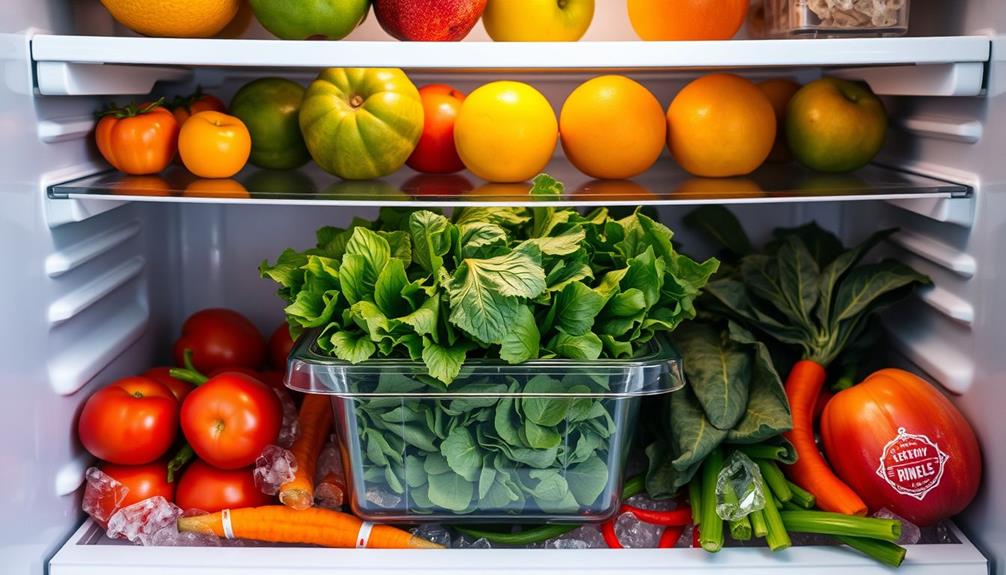
When organizing your refrigerator, always store raw fish on the top shelf. This placement minimizes the risk of cross-contamination with other foods. It's essential to wrap the fish tightly in plastic wrap or foil and keep it in a sealed container to prevent exposure to contaminants. Below the fish, you can store whole cuts of beef and pork on the middle shelf, while ground meats go lower. Finally, raw poultry should be on the bottom shelf to avoid any leakage. Understanding these storage tips can greatly enhance your food safety practices. You'll discover even more helpful advice ahead.
Key Takeaways
- Store raw fish on the top shelf to minimize the risk of cross-contamination with other foods.
- Whole cuts of beef and pork should be placed directly below fish on the middle shelf.
- Ground meats must be stored on the lower middle shelf, beneath whole cuts of beef and pork.
- Raw poultry should always be kept on the bottom shelf to prevent juices from contaminating other items.
- Use sealed containers for all raw foods to further reduce the risk of contamination.
Importance of Food Hierarchy
When it comes to food storage, understanding the importance of food hierarchy is vital for maintaining safety in your kitchen. By organizing your refrigerator correctly, you can minimize the risk of cross-contamination, which is essential for raw food safety. Proper food storage practices can help ward off foodborne illnesses, similar to how cold medications should be chosen for effective relief.
Start with seafood, which should always be stored on the top shelf. It's the most perishable and should be kept above other raw foods to prevent any juices from dripping down.
Next, place whole cuts of beef and pork on the middle shelf. This keeps them safely above ground meats and seafood, adhering to the food storage hierarchy. Ground meats and fish should be stored on the lower middle shelf, where they can be contained separately from poultry, which you must always put on the bottom shelf. This prevents any juices from raw poultry from contaminating other foods, markedly reducing cross-contamination risks.
Following this organization not only minimizes the chances of foodborne illnesses but also makes it easier to access your ingredients when cooking. By adhering to these guidelines, you guarantee that your kitchen remains safe and efficient while handling raw foods.
Storing Fish Correctly

When storing fish, it's vital to prioritize proper storage techniques to keep it fresh and safe.
You should always maintain the right temperature and take steps to prevent cross-contamination, especially with other raw foods.
Regular cleaning of storage areas is essential to guarantee hygiene and minimize the risk of foodborne illnesses.
Importance of Proper Storage
Storing fish correctly is essential for maintaining its freshness and guaranteeing food safety. To prevent contamination, always place fish on the top shelf of your refrigerator. This helps minimize the risk of juices leaking from raw meats or poultry stored below, which could spoil your fish.
Additionally, consider incorporating aquatic exercise into your routine, as it promotes overall health which is beneficial when handling and preparing food. Wrapping your fish tightly in plastic wrap or aluminum foil is important, as it prevents exposure to contaminants and helps maintain its quality.
Be certain to store fish in a sealed container, keeping it separate from raw meats and poultry. This extra layer of protection further reduces the risk of cross-contamination.
Regularly check the use-by dates on your fish to verify you're consuming it while it's still safe. Proper refrigeration is essential; keep your fish at or below 5 °C to inhibit harmful bacteria growth.
Temperature Control Guidelines
Maintaining the right temperature is essential for guaranteeing your fish stays fresh and safe to eat. Store your fish on the top shelf of the fridge to avoid cross-contamination with other raw foods like beef and pork. The ideal storage temperature for fish is below 5 °C, which helps minimize bacterial growth and keeps it fresh.
Here's a quick overview of proper fish storage:
| Storage Guidelines | Details |
|---|---|
| Ideal Temperature | Below 5 °C |
| Storage Location | Top shelf of the fridge |
| Wrap | Tightly in plastic wrap or aluminum foil |
| Below Fish | Whole cuts of beef and pork |
Always check the temperature of your fridge regularly to guarantee it stays at or below that critical level. Wrapping your fish tightly prevents exposure to contaminants, further maintaining its quality. Following these temperature control guidelines will help keep your fish safe and delicious for you and your family.
Cross-Contamination Prevention Strategies
To keep your fish safe from cross-contamination, always place it on the top shelf of your refrigerator. This prevents fish juices from dripping onto other raw foods, reducing the risk of spoilage and bacteria spreading.
Proper food handling and storage practices are fundamental to maintaining a safe kitchen environment, especially when it comes to preventing cross-contact with other raw ingredients.
Here are three fundamental strategies for storing fish correctly:
- Use a Sealed Container: Store your fish in a well-sealed container or tightly wrapped to minimize any leakage. This is critical in preventing cross-contamination with other foods.
- Separate Storage: Always keep fish separate from raw poultry and meats. These should be placed on the lower shelves to avoid any drips that could contaminate the fish.
- Monitor Temperature: Verify your refrigerator maintains a temperature of 5 °C or below. This is essential for temperature management and helps inhibit bacterial growth, keeping your fish fresh longer.
Regularly check your fish for signs of spoilage and consume or cook it within a safe timeframe.
Poultry Safety Practices
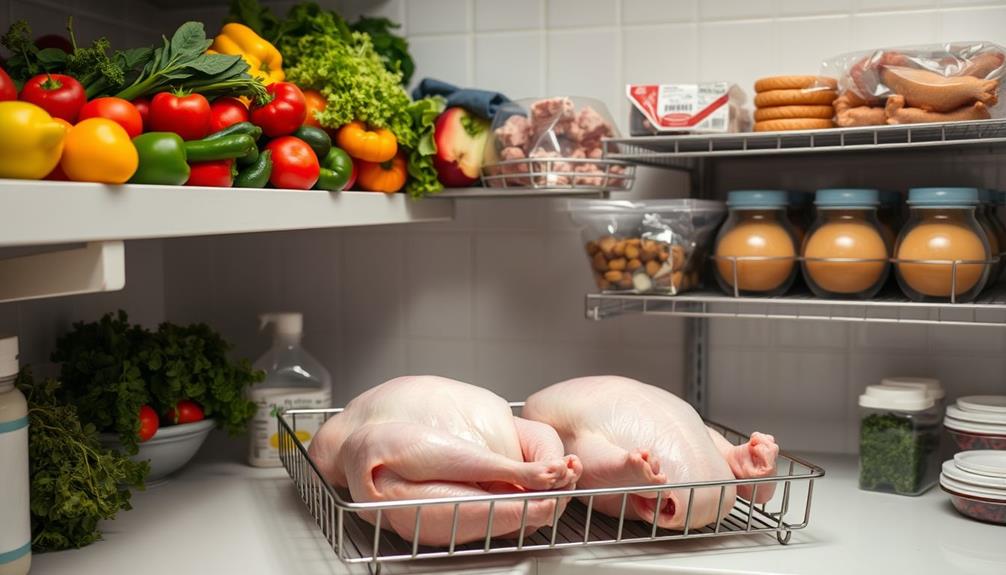
When it comes to poultry safety, proper storage is key to preventing foodborne illnesses. Always store raw poultry on the bottom shelf of your fridge to avoid cross-contamination, and make sure it's in a sealed container.
Additionally, understanding the importance of budgeting for food expenses can help you manage your grocery costs effectively.
Keeping poultry at safe cooking temperatures is just as important—let's explore how to do this effectively.
Proper Storage Hierarchy
Properly organizing your refrigerator is vital for poultry safety and overall food hygiene. Establishing a clear storage hierarchy helps prevent cross-contamination and guarantees your food stays safe.
For instance, keeping your raw meats properly stored can greatly reduce the risk of foodborne illnesses, as noted in hamster care and costs regarding proper food handling.
Here's how you can organize your raw foods effectively:
- Top Shelf: Store whole fish here. Keeping it above all other raw foods minimizes cross-contamination risks.
- Middle Shelf: Place whole cuts of beef and pork on this level, guaranteeing they're below fish but above ground meats. This organization helps maintain proper cooking temperature guidelines.
- Bottom Shelf: Raw poultry belongs here to prevent its juices from dripping onto other foods, especially ready-to-eat items located above.
Always wrap your raw foods securely in plastic wrap or aluminum foil to prevent leakage and contamination within the fridge.
By following this structured organization, you greatly reduce the chances of harmful bacteria spreading among your food.
Avoid Cross-Contamination Techniques
Cross-contamination is a serious concern in the kitchen, especially with raw poultry. To guarantee food safety, always store raw poultry on the bottom shelf of your refrigerator. This prevents its juices from dripping onto other foods, which can lead to harmful bacteria spreading. Use a sealed container or plastic bag to minimize any risk of leakage.
Early detection of foodborne illnesses can be vital, much like the importance of mammography for early detection in breast cancer.
It's essential to follow the food hierarchy; store raw poultry above raw meats and seafood. This simple step can considerably reduce the risk of cross-contamination. When preparing meals, always use separate cutting boards for raw poultry and other ingredients to avoid cross-contact of pathogens like Salmonella.
Maintaining proper refrigeration temperatures is vital, too—ideally below 5 °C. This inhibits the growth of harmful bacteria that can thrive in warmer environments. Regularly check your refrigerator to guarantee it's keeping the right temperatures.
Safe Cooking Temperatures
Cooking poultry safely is vital for preventing foodborne illnesses. To guarantee you're cooking your poultry properly, always check the internal temperature with a food thermometer. The safe cooking temperature for all poultry products, including whole birds and ground poultry, is 165°F (74°C).
It's essential to maintain a clean cooking environment and utilize proper food storage practices for peak safety, especially if you have pets that might introduce allergens into your home, as best vacuums for dust removal in 2024 can help eliminate any lingering particles.
Here are some key tips to follow:
- Store Raw Poultry: Always keep raw poultry on the bottom shelf of your fridge to prevent juices dripping onto other foods and causing cross-contamination.
- Thawing Methods: Thaw frozen poultry safely in the refrigerator, in cold water, or in the microwave. Avoid thawing at room temperature to minimize bacterial growth.
- Leftover Cooked Poultry: Refrigerate any leftover cooked poultry within two hours of cooking. Consume it within 3-4 days for peak food safety.
Managing Raw Meat Storage

When it comes to managing raw meat storage, organization is key to ensuring food safety.
Start by storing fish on the top shelf of your refrigerator. This placement minimizes the risk of contamination with other raw foods.
It's also important to maintain a clean refrigerator environment to prevent any airborne bacteria from settling on surfaces, much like the air purifier maintenance dos and don'ts.
Below the fish, place whole cuts of beef and pork on the middle shelf. This arrangement prevents any drips that could potentially contaminate lower shelves.
Ground meats, including beef and pork, should occupy a lower shelf to reduce the risk of bacterial spread from their juices.
Preventing Cross-Contamination
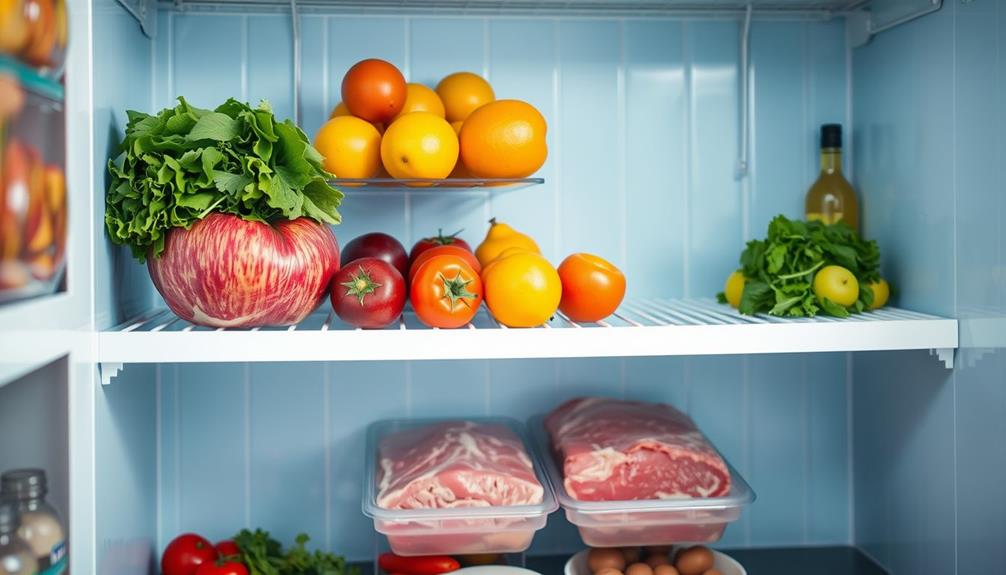
Maintaining a safe food environment means taking steps to prevent cross-contamination in your kitchen. To keep harmful bacteria at bay, you need to store raw foods correctly and guarantee that they're separate from cooked foods. Here are some essential tips to help you achieve that:
1. Store Raw Foods in Order: Always place fish at the top, followed by whole cuts of beef or pork, ground meats, and finally poultry at the bottom. This arrangement minimizes the risk of drips and leakage contaminating other items. Additionally, it’s important to store raw foods in sealed containers or leak-proof bags to further prevent cross-contamination. When storing raw foods in the refrigerator, always keep them separate from ready-to-eat items, and use different cutting boards and utensils for preparing raw meats and other foods. Following these raw food storage tips can help reduce the risk of foodborne illness and keep your kitchen safe.
Additionally, just as proper maintenance is vital for heat pumps to function effectively, maintaining proper food storage practices is fundamental for food safety.
2. Use Sealed Containers: Keep raw foods in sealed containers or plastic bags. This greatly reduces the chances of leakage, which can spread harmful bacteria and lead to foodborne illnesses.
Using sealed containers is similar to how energy-saving features in heat pumps help minimize inefficiencies and enhance performance.
3. Organize Food Storage: Regularly check and organize your food storage. Confirm that cooked foods are always stored above raw items to maintain that vital separation.
Food Safety Guidelines

Food safety guidelines are essential for guaranteeing that your raw ingredients remain safe to eat and won't lead to foodborne illnesses. To maintain a safe storage hierarchy, place raw fish at the top of your refrigerator. This minimizes the risk of cross-contamination from its juices.
Additionally, understanding the importance of proper food handling can greatly reduce health risks associated with foodborne pathogens, similar to the ways caregivers manage financial considerations for elderly care to guarantee safety and well-being.
Below the fish, store whole cuts of beef and pork, which are less likely to harbor harmful bacteria compared to ground meats. Ground meats, like ground beef and pork, should be stored beneath whole cuts to prevent bacterial spread.
Finally, keep raw poultry—such as whole and ground chicken—on the bottom shelf, as it poses the highest risk of carrying pathogens like salmonella.
Always wrap your raw foods securely in aluminum foil or plastic wrap. This prevents exposure to contaminants and avoids any leakage that could affect other foods in your fridge.
Best Storage Containers
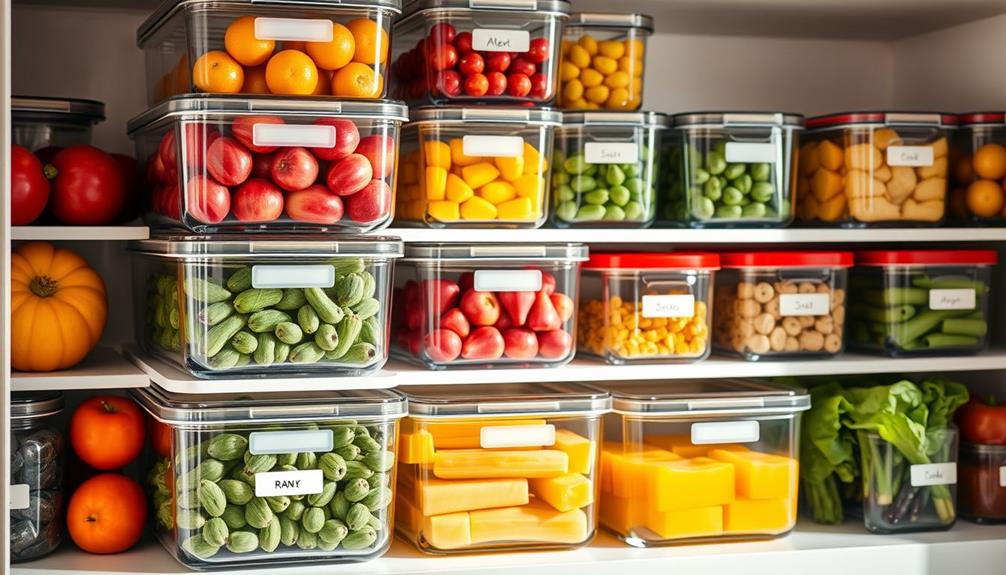
Choosing the right storage containers can make a big difference in keeping your raw foods safe and fresh. To effectively prevent cross-contamination and maintain the quality of your ingredients, consider these tips:
- Use airtight containers: Opt for glass or BPA-free plastic containers with tight-fitting lids. They not only prevent leaks but also keep odors from mingling and help maintain freshness.
- Label everything: Clearly label your storage containers with the contents and date of storage. This practice guarantees you track use-by dates and minimizes the risk of using spoiled food.
- Create visual distinction: Utilize separate colored containers for different food groups like raw meat, poultry, and seafood. This method aids in easily identifying contents and greatly reduces cross-contamination risks.
For freezer use, choose thicker food storage bags designed for that purpose. They're less likely to puncture or leak, guaranteeing your raw foods stay safe.
Frequently Asked Questions
Which Raw Food Should Be Stored Above?
When storing raw foods, you should place whole fish on the top shelf. This helps reduce cross-contamination risks. Remember to wrap them securely to prevent any leaks that could affect other items below.
Which Food Should Be Stored Above?
Imagine the chaos of a kitchen gone wrong. You should store fish on the top shelf to prevent cross-contamination. It's essential for maintaining safety, ensuring your meals are delicious and free from any harmful bacteria.
Which Food Should Be Stored Above Others in the Refrigerator?
When storing food in your refrigerator, always place fish on the top shelf. It minimizes cross-contamination risks. Below that, keep whole cuts of beef and pork, followed by ground meats and poultry on the bottom.
What Is the Proper Way of Storing Raw Food?
Imagine your fridge as a well-organized library. When storing raw food, wrap it tightly, use sealed containers, and arrange by type. This keeps everything fresh and prevents contamination, just like protecting valuable books from damage.
Conclusion
By understanding the importance of food hierarchy and proper storage techniques, you can keep your kitchen safe and your meals delicious. Just like stacking building blocks, each layer of food needs to be placed thoughtfully to prevent disaster. Remember to store fish above poultry, and always keep raw meat at the bottom. With these tips, you'll guarantee freshness while protecting your loved ones from cross-contamination. Your kitchen can be a safe haven for healthy eating!
Rachael, the Editor in Chief of RachaelsRawFood.com, is an inspiring and passionate individual who has dedicated her life to promoting the benefits of a raw food lifestyle. Known for her vibrant and energetic personality, Rachael has built a strong online presence that has transformed her personal journey into a thriving community of raw food enthusiasts.
-

 Raw Food Recipes2 months ago
Raw Food Recipes2 months agoHow Much Raw Food Do You Feed Your Dog? A Calculator Guide
-
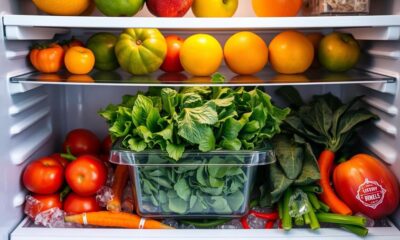
 Kitchen Essentials for Raw Food Preparation2 months ago
Kitchen Essentials for Raw Food Preparation2 months agoWhich Raw Food Should Be Stored Above? Essential Tips
-
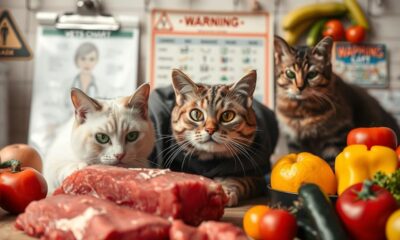
 Getting Started with Raw Food2 months ago
Getting Started with Raw Food2 months agoWhy Is Raw Food Bad for Cats? Essential Information
-
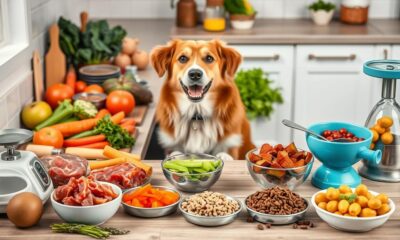
 Getting Started with Raw Food2 months ago
Getting Started with Raw Food2 months agoCan I Switch My Dog to Raw Food? What You Need to Know
-
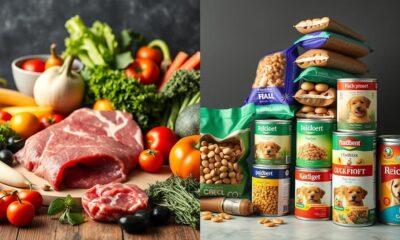
 Raw Food Recipes2 months ago
Raw Food Recipes2 months agoRaw Food Vs. Kibble Cost: a Comprehensive Comparison
-

 Getting Started with Raw Food2 months ago
Getting Started with Raw Food2 months agoDoes Raw Food Make Dogs Constipated? Find Out Here
-

 Raw Food Recipes2 months ago
Raw Food Recipes2 months agoHow Much Raw Food Do I Feed My Dog Calculator: Find the Right Amount
-

 Health and Wellness2 months ago
Health and Wellness2 months agoWhy Do Chinese People Eat Raw Food? Cultural Insights
